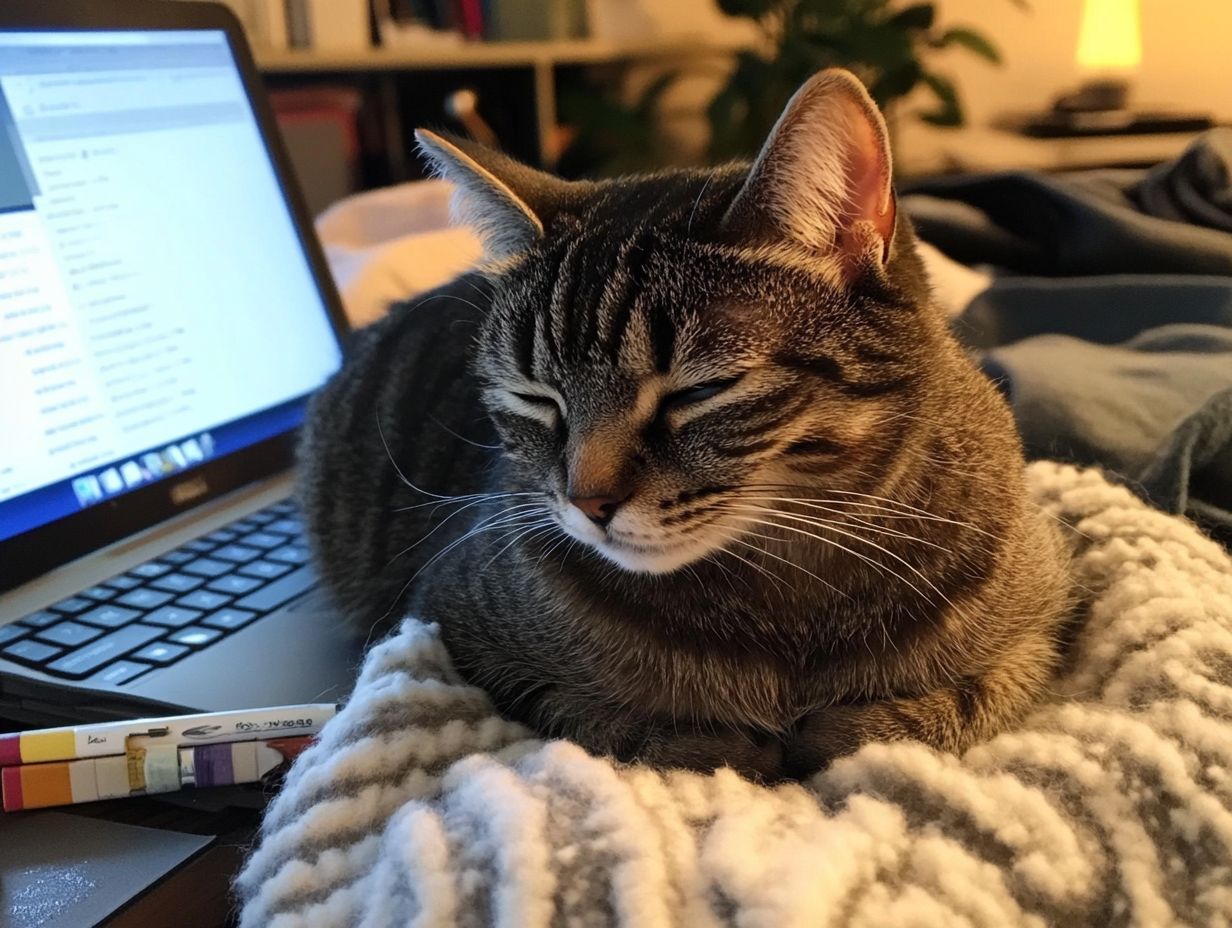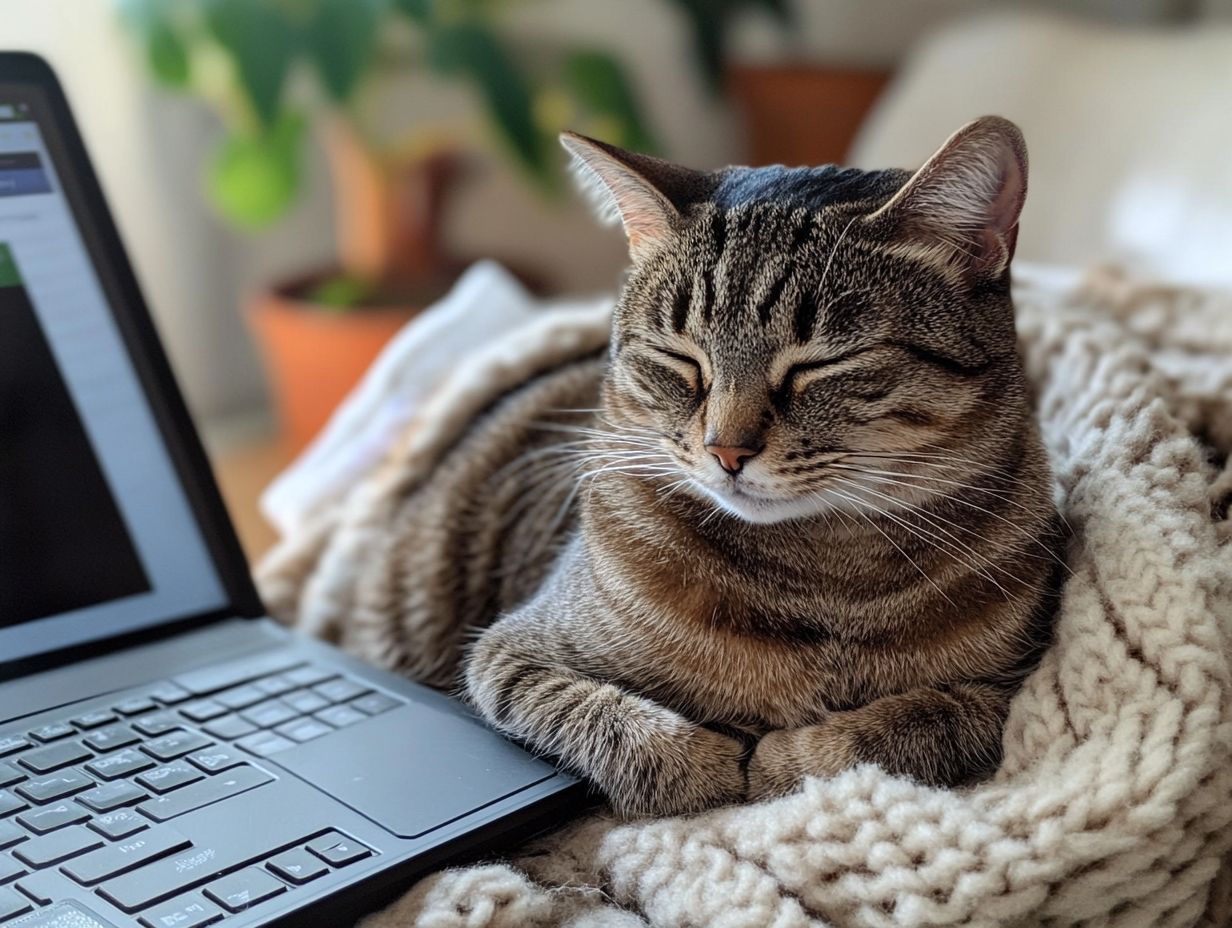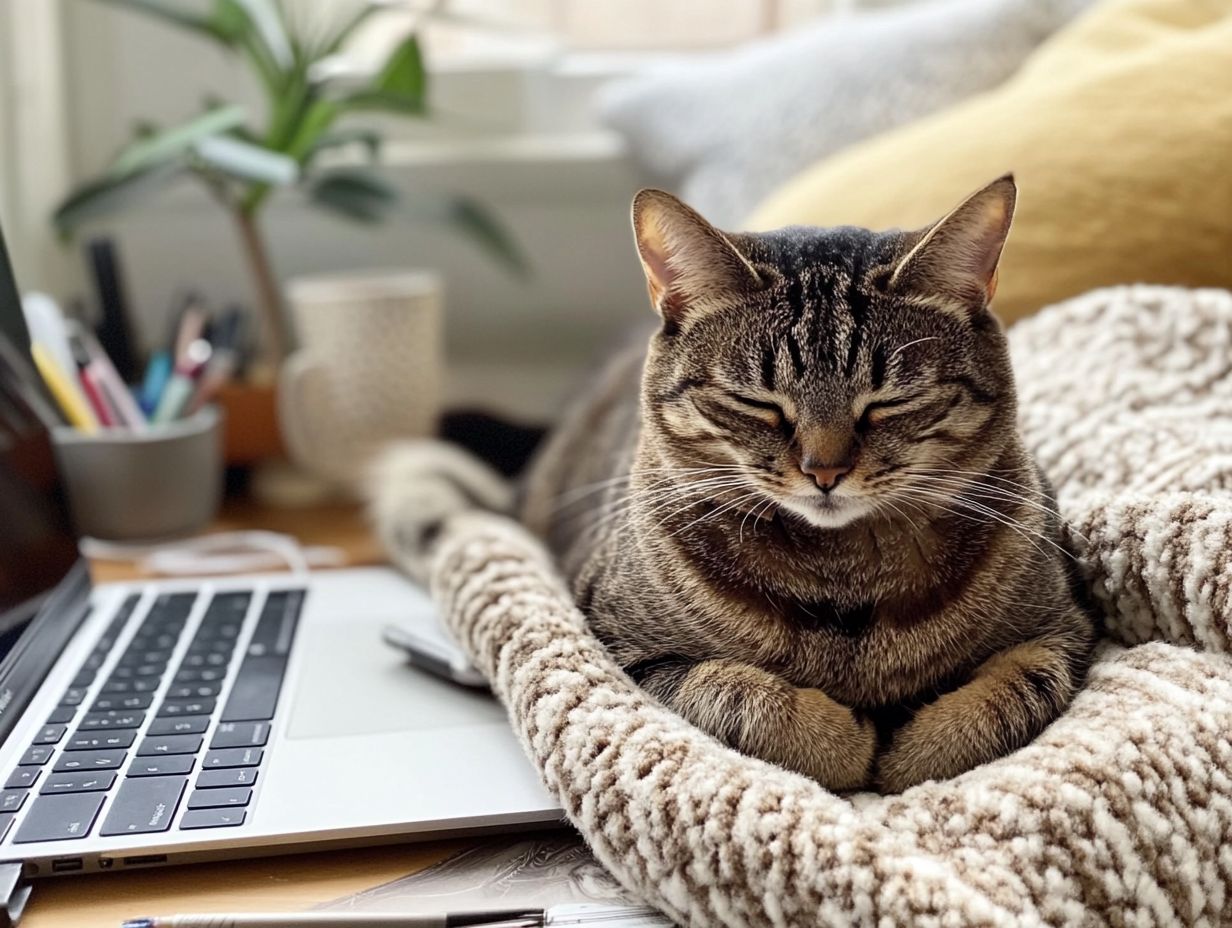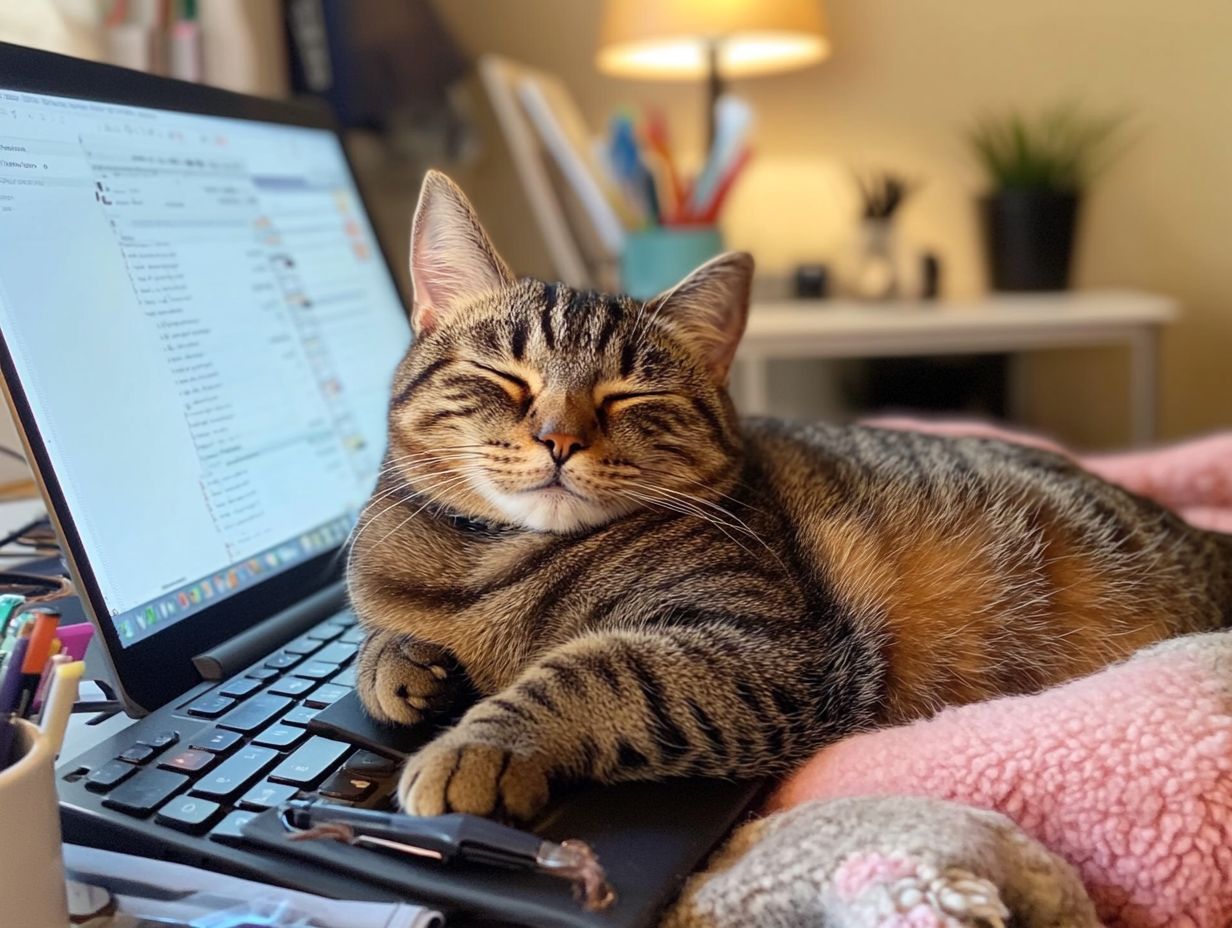Have you ever wondered why your cat seems irresistibly drawn to your laptop? You’re not alone! This quirky behavior can puzzle even the most devoted cat owners, sparking numerous questions about feline behavior and their curious attraction to keyboards.
We explore the reasons behind this phenomenon, from the warmth of the device to their instinctual need for attention, comfort, and territory marking. This behavior is a perfect example of how cats convey their emotional needs and ownership of their space. According to studies like “Feline Behavior and the Importance of Environmental Enrichment,” these behaviors are deeply rooted in feline instincts.
We’ll also discuss whether it’s normal, if it could be harmful, and share some tips on how to redirect this amusing habit through positive reinforcement. Understanding these behaviors can help mitigate potential distractions and ensure a harmonious environment.
Plus, enjoy a few lighthearted examples of our feline friends in action, such as Zadie and Ruby, who turn laptops into playgrounds!
Key Takeaways:

Why Do Cats Like to Sit on Laptops?
The behavior of cats sitting on laptops can often perplex their owners; however, it is rooted in a combination of curiosity, a desire for warmth, and the need for companionship. While this interaction may seem trivial, it actually reflects deeper feline behaviors and emotional signals that reveal how cats perceive their environment. Stress or a lack of stimulation may lead cats to seek warmth from electronic devices as well.
Renowned veterinary expert Dr. David Sands from Liverpool University emphasizes that understanding this behavior can strengthen the bond between pet and owner, ultimately enhancing their shared living experience.
Furthermore, the presence of laptops offers a unique opportunity for cats to explore and mark their territory within their domestic space, projecting their dominance through scent markings. Observing their body language can help owners interpret their emotional cues and needs.
Is It Normal for Cats to Sit on Laptops?
It is entirely normal for cats to sit on laptops, as this behavior reflects their natural curiosity and the comfort they find in their surroundings. Owners often appreciate this playful and affectionate behavior, as it reinforces the bond between cats and humans.
Understanding that this tendency is linked to their need for warmth and affection can help owners interpret their pets’ emotional cues more effectively. However, it does raise the question of whether this behavior distracts owners from their daily tasks and affects their productivity. For multi-cat households, dynamics like competition for space may also come into play.
Do All Cats Sit on Laptops?
While many cats are known for sitting on laptops, not all cats engage in this behavior; individual personalities, breeds, and playful tendencies significantly influence such habits. For example, cats like Zadie, Amanda, and Ruby may frequently seek out laptops for warmth and comfort, while others might prefer different spaces. Observing their unique behavioral patterns can reveal much about their individual preferences and relationships with their owners.
For instance, Zadie may be more extroverted, drawn to the warm glow of a laptop screen that mimics sunlight, which she finds comforting. In contrast, Amanda might favor her owner’s lap, seeking direct interaction and cuddles rather than technological warmth. Ruby, a curious kitten, may view the laptop as an intriguing platform for exploration, often pawing at the keyboard with her curious paws.
Different developmental stages also play a role—kittens, adults, and senior cats might engage with laptops differently. These distinctions underscore the importance of a cat’s environment and personality traits in shaping their choices, contributing to a delightful array of feline behaviors and experiences within the home.
Is This Behavior Harmful for Cats?
While the dangers of cats sitting on laptops are generally mild, they include the risks of neglecting the cats’ health needs, overheating, and distractions. Veterinary experts, such as Dr. David Sands, highlight the potential threats associated with this behavior and emphasize the importance of monitoring it to ensure the physical comfort and health of the cats. Regular cleaning and ensuring that laptops do not become primary heat sources can mitigate these risks. Additionally, providing alternative safe resting spots can encourage desirable behaviors.
In cases where this behavior becomes problematic, consider consulting a veterinarian or an animal behaviorist for tailored advice.
Understanding the motivations behind this behavior can help owners take appropriate steps to avoid dangerous situations. From a cat’s viewpoint, seeking warmth and comfort is a natural instinct tied to their survival and comfort, making laptops an ideal resting spot due to the heat they emit. Providing alternative heating options can help redirect this behavior, fostering a more suitable environment for both the cat and the owner.
Although this behavior is typically harmless, it can distract owners from work and important tasks, leading to frustration and potential accidents. Furthermore, laptops can become heat sources, increasing the risk of overheating both the device and the cat, potentially affecting their physical health and safety. Owners should be cautious, as repeated access to warm surfaces may encourage their cats to develop a habit that could lead to complications, including skin or respiratory issues. Providing alternative warm resting spaces, like heated beds, can help mitigate these dangers and ensure their well-being.
What Are the Possible Explanations for This Behavior?

Cats often sit on laptops due to their instinctual attraction to the warmth they generate, their natural curiosity about their surroundings, and their desire for attention from their owners. This behavior reflects their emotional needs and can be connected to their territorial instincts and playful nature. Studies have shown that warmth-seeking behavior is common among cats, highlighting their need for security and comfort.
By understanding these underlying motivations, owners can enhance their companionship experience with their feline friends. For multi-cat households, dynamics can change, and competition for warm surfaces may lead to stress or anxiety among pets.
1. Warmth and Comfort
Cats have a natural desire for warmth and comfort, which is why many of them enjoy the heat from laptop computers. This warmth provides a sense of security and relaxation, positively impacting their emotional well-being. If you’re curious about this behavior, check out Why Do Cats Sit on Laptops?.
Understanding this need allows owners to create warm spaces for their cats to lie down. Simple solutions include:
- Placing blankets in sunny spots
- Investing in heated pet beds designed specifically for cats
Additionally, owners can enhance comfort by setting up soft resting areas on top of cabinets or high shelving units where sunlight creates warm napping spots. Enclosed soft beds mimic the warmth of a mother cat, appealing to their natural instincts.
By ensuring their cats’ immediate surroundings are filled with warmth and kindness, owners help foster an environment that nurtures both the body and spirit, making their pets feel safe and secure. Stress and anxiety can also manifest in behavior, so monitoring a cat’s emotional state is crucial.
2. Attention Seeking
Attention-seeking behavior is common among cats, and sitting on a laptop is an effective way for them to engage their owners. This playful interaction often encourages cuddling and affection, which strengthens the emotional bond between the pet and the owner. Recognizing their body language, such as purring or kneading, can help owners respond appropriately.
Being aware of these signals can motivate owners to provide more interactive experiences. These behaviors indicate that the cat wants to be near their owner and serve as an invitation for chatting and playtime. When cats display these endearing actions, it highlights their social instincts and need for companionship. Engaging with a cat during these moments can transform an otherwise mundane task into a fun experience, allowing both parties to better understand each other’s personalities.
Additionally, this interaction can help alleviate feelings of loneliness for both the pet and the owner, fostering a more harmonious living environment. Introducing scheduled playtime or engaging in mutual activities can further enhance the bond.
3. Curiosity
Curiosity is a well-known trait of cats, driving them to investigate their surroundings, including laptops. This behavior reflects their instinctual need to explore new territories in order to understand their unique smells and sounds. Allowing cats to safely explore their environment helps fulfill their inquisitive nature. Engaging the cat’s curiosity through environmental enrichment—like cat trees, interactive toys, or puzzle feeders—can provide stimulating alternatives to sitting on a laptop.
Cats possess a natural instinct to examine every nook and cranny of their homes, often transforming even the most mundane spaces into bustling territories ripe for exploration. Their keen senses compel them to sniff, taste, and inspect any new additions to their environment, with boxes or bags frequently becoming the focus of their playful investigations, leading to games and surprising leaps. It’s important to recognize that different breeds may exhibit varying propensities for warmth-seeking behavior, influenced by their genetic traits.
Engaging in these curious behaviors provides cats with mental stimulation and aids them in adjusting to and learning about their surroundings. Their exploration is not confined to indoors; cats also venture outside, where their curiosity leads them to spy on birds or insects from a safe distance, stalking them to hone their hunting skills.
4. Territorial Instincts
Cats are inherently territorial animals, and their tendency to sit on laptops may serve as a form of territory marking. By choosing to sit on laptops, cats communicate their ownership of the object and their comfort in being physically close to it. This behavior can be seen as a positive adaptation of their natural instincts to the modern world.
Understanding this aspect of territoriality can help pet owners grasp the motivations behind their pets’ actions. For cats, territoriality extends beyond physical spaces to include any object that carries their scent, such as blankets, the family couch, or a laptop. When cats sit on these items, they not only assert ownership but also demonstrate a protective instinct likely inherited from their ancestors.
Recognizing this behavior can enhance the bond between owners and their pets by fostering an understanding of their motivations, while also creating an environment that honors the cat’s territorial instincts and allows for shared spaces.
Territorial instincts vary among kittens, adult cats, and senior cats. Kittens are naturally curious and may explore their territory more playfully, while adults tend to assert ownership and mark their space. Senior cats may become more territorial due to changes in their physical health or decreased confidence.
How Can You Prevent Cats from Sitting on Laptops?

### How to Keep Cats Off Laptops
Understanding why cats are drawn to laptops can help in finding effective ways to keep them away. According to Dr. David Sands, an expert in feline behavior (source: Example Source), the primary reason cats like to sit on laptops is that they emit heat. Cats love warm places, and when they see their owners working on their computers, they want to be close to them. The warmth of the laptop can be comforting, and the attention from their owners is rewarding. Cats may also be drawn to the keyboard due to its texture and the familiar scent of their owners.
To keep cats off laptops, it’s important to recognize their needs and provide suitable alternatives. Ensuring that there are plenty of warm spots nearby can help divert their attention from the heated computers. Training cats not to jump on laptops, while rewarding them for choosing their own designated spots, can also be effective. For more insight into this behavior, check out Why Do Cats Sit on Laptops?. Additional insights can be found through research conducted by Liverpool University and the Canine and Feline Behaviour Association.
Environmental enrichment can also reduce the urge for territorial marking. Engaging your cat with toys that mimic hunting, such as feather wands or laser pointers, can satisfy their natural instincts. Providing scratching posts and interactive playtime can help keep them mentally stimulated and reduce stress.
Understanding feline body language is crucial for improving communication and bonding with your cat. Recognizing signs of comfort or discomfort can help foster a trusting relationship.
Addressing stress and anxiety is key to managing territorial behaviors. Creating a calm environment, using pheromone diffusers, and minimizing loud noises can significantly help in reducing your cat’s anxiety levels.
Here are some tips to encourage cats to stay away from laptops and other devices:
- Reward Positive Behavior: Encourage your cat to move away from the laptop by offering treats and praise when they do.
- Create a Dedicated Space: Provide a cozy area nearby with a comfortable cat bed, blankets, or pads. This can include a heated bed or an area with your scent to make it more inviting for your pet.
- Offer Alternatives: Provide various comfortable choices throughout your home, such as a cat tree, scratching post, or heated blankets.
### How to Train Cats to Stay Away from Laptops
Training cats to avoid certain areas without using punishment can be effective. Cats are often more motivated by praise and rewards than by negative reinforcement. If your cat jumps onto the laptop, try to catch them before they leave and offer praise and treats. Consistent training can help modify their behaviors and encourage positive patterns.
Alternatively, you can place a towel or blanket on the laptop that carries your scent. This way, your cat can enjoy being near your familiar scent while staying away from the computer itself.
1. Provide Alternative Comfortable Spots
Providing alternative comfortable spots for cats can significantly reduce their tendency to sit on laptops by catering to their natural instincts for warmth and security.
Cozy beds, heated cat pads, or specially created areas next to their owners can create an inviting atmosphere that satisfies these needs. Elevated perches or snug hiding spots can further enhance a cat’s sense of safety, allowing them to observe their surroundings from a secure vantage point.
In multi-cat households, it’s vital to manage resources effectively to reduce territorial disputes. Ensure there are enough food bowls, litter boxes, and resting areas to prevent competition among cats.
It’s important to consider the ethical implications of altering a cat’s natural behavior. Changes in their environment can impact their well-being, so any adjustments should prioritize their comfort and happiness.
Proactive strategies for early intervention can prevent problematic behaviors like territorial marking from escalating. Regular playtime and socialization can help mitigate these issues before they arise.
Finally, noting the health-behavior connection is essential. If a cat exhibits unusual territorial behaviors, consult a veterinarian to rule out medical issues that may contribute to the problem.
Soft blankets or cushions placed in quieter areas are ideal for sleeping, especially in environments with fluctuating noise levels. Using natural materials like wool or fleece aligns with a cat’s instinct to seek warmth and comfort. According to the American Association of Feline Practitioners, cats prefer warm and secure sleeping environments.
Additionally, placing a cat bed near a sunny window can entice them away from your laptop and into a cozy alternative, reducing the need for your cat to explore your keyboard. This arrangement can alleviate anxiety in cats, making them feel more secure in their environment.
2. Deterrents
The most effective way to keep cats off laptops is to employ deterrents such as gentle sprays, textured mats, or physical barriers that signal to the cat that the laptop area is off-limits. It’s important to note that not all cats respond similarly to these methods, as individual personality and breed can influence behavior.
Additionally, introducing scent-based deterrents like citrus or lavender can help create an unwelcoming environment for cats. However, consider the cat’s unique preferences and stress levels, as some scents may not be effective for all.
Another strategy is to provide cat furniture or create other nearby cozy spots that are inviting and comfortable for them. Recognizing signs of stress, such as excessive grooming or hiding, can help identify triggers for problematic behaviors like sitting on laptops.
Behavior modification techniques, such as rewarding cats for using their designated spaces, can also reinforce positive habits and reduce unwanted behavior. It’s crucial to avoid punishment, as studies in the Journal of Veterinary Behavior indicate that punishment can lead to fear and anxiety in cats.
Varying these methods is essential to maintain their effectiveness over time, as cats are naturally curious and can adapt to repetitive stimuli. For more insights into feline behavior, check out this article on Why Do Cats Sit on Laptops?, featuring information from the Association for the Study of Animal Behaviour.
3. Training and Positive Reinforcement
Training cats to avoid sitting on laptops can be accomplished through positive reinforcement strategies that encourage desired behaviors while strengthening the bond between pets and their owners. Rewarding cats when they choose alternative spots can help promote long-term behavior change, particularly when considering their developmental stages.
To implement this effectively, it is important to identify comfortable alternative locations, such as a cozy bed nearby or a sunny windowsill. Whenever your feline friend opts for these designated areas instead of the keyboard, offering treats or enthusiastic praise will reinforce that choice. Consistency is crucial; ensuring that all household members follow the same training protocols helps prevent confusion.
Additionally, using interactive toys can redirect their attention away from screens while keeping them engaged. By creating a positive training environment, owners can not only curb unwanted behaviors but also enhance the overall well-being and happiness of their companions. This approach aligns with findings from veterinary medicine experts and further fosters companionship between you and your feline friend.
What Are Some Funny and Cute Examples of Cats Sitting on Laptops?
Many famous cats, such as Zadie and Ruby, have been seen sitting on laptops. The humorous antics of Professor Scribbles and the affectionate nudges from Baxter can make owners laugh while trying to work.
The amusing and endearing instances of cats sitting on laptops often highlight the playful and affectionate nature of these pets. For example, Coriander batting at the keyboard as if he were typing, and Elvira curled up on a warm laptop, create unique moments that showcase the bond between owners and their cats, as well as the love and playfulness cats offer in return.
Other cats, like Sno-Cone and Elston, exhibit similar behavior, turning their owners’ workspaces into feline playgrounds. These interactions can lead to humorous distractions, particularly when a cat inadvertently hits the keys to type gibberish sentences that evoke a good laugh from their human. A cat walking across the keyboard, as if to proclaim, “This is my throne now,” is undeniably cute and adds a touch of emotional connection.
The charm of these silly moments lies in their ability to strengthen the bond between pets and humans. Both cats and dogs often enjoy being near their owners during work or playtime, and their choice to join their human adds special value to these moments, filled with humor and affection.
These moments also highlight the territory marking behavior common in cats, as they often choose to sit on items that carry their owners’ scent and provide a sense of ownership and dominance. Understanding these behaviors and offering appropriate alternatives can mitigate unwanted laptop sitting.
Frequently Asked Questions

Why Do Cats Sit on Laptops?
This question has been a subject of much research and interest among feline behavior experts, as noted in studies from the Journal of Feline Medicine and Surgery.
Cats are naturally drawn to warmth and comfort, and laptops provide both. The heat generated by a laptop’s battery and the soft keyboard make it an ideal spot for cats to relax. Environmental factors, such as ambient temperature and available resting spots in the home, also play a significant role in this behavior.
Do all cats sit on laptops?
Not all cats are fond of sitting on laptops. Some may prefer other warm spots, such as a sunny windowsill or a cozy bed. Younger cats may be more playful and curious about laptops compared to adults and seniors. It ultimately depends on the individual cat’s preferences, their unique behaviors, and factors like breed and genetics.
Can sitting on a laptop harm my cat?
In general, a cat sitting on a laptop is not harmful; however, if they accidentally press keys or knock over the laptop, it could cause damage. It’s best to keep an eye on your cat and your laptop to prevent any accidents. Providing alternative distractions can help keep their curiosity at bay. Rewarding your cat when they choose their designated spot over the laptop can reinforce positive behaviors.
Why do cats always choose the most inconvenient times to sit on laptops?
Cats don’t have a concept of “convenient” times. They simply go where they please and do what they want, often coinciding with their natural territory marking tendencies. This behavior may also be a response to stress or anxiety, as they seek warmth and security. It’s important to create designated spots for your cat to sit and redirect them from your laptop if needed.
Is there a way to prevent my cat from sitting on my laptop?
Consulting with experts in feline behavior, like those at the American Association of Feline Practitioners, can provide additional strategies. One method is to provide them with a comfy alternative, such as a heated bed or a cozy cushion. You can also try placing a towel or blanket on top of your laptop to discourage your cat from sitting directly on it. Additionally, engaging your cat with interactive toys can keep them entertained and away from your keyboard. Consider enriching your environment with cat trees or warm blankets in designated areas to encourage preferred resting spots.
Do all cats sit on laptops for the same reason?
Cats may sit on laptops for various reasons, including warmth, comfort, seeking attention, or simply out of curiosity. Each cat may have their own unique reason for choosing to sit on a laptop. Observing these patterns can help owners better understand their emotional needs and territory behaviors. It’s also important to note how this behavior can impact the human-cat bond, as a cat sitting on a laptop might be seeking attention from its owner.
Understanding feline behavior
Recognizing feline body language cues that indicate contentment or stress when near laptops can also assist in understanding their needs. If needed, consider consulting a feline behaviorist for personalized guidance. Encouraging further learning through resources such as online courses or recommended books can enrich both cat and owner experiences.